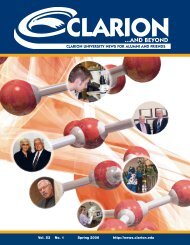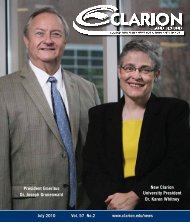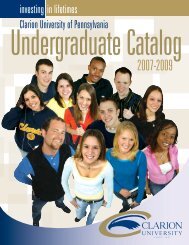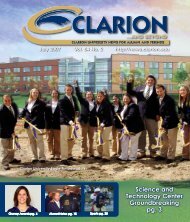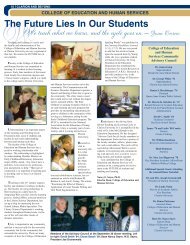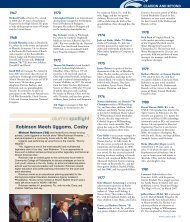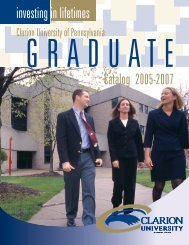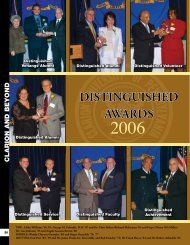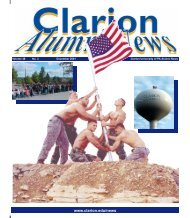Graduate - Clarion University
Graduate - Clarion University
Graduate - Clarion University
- No tags were found...
You also want an ePaper? Increase the reach of your titles
YUMPU automatically turns print PDFs into web optimized ePapers that Google loves.
96 <strong>Clarion</strong> <strong>University</strong> of PennsylvaniaSpeech LanguagePathologyCSD 505: Articulatory and Phonological Disorders in Children 3 s.h.Articulatory and phonological features of the American English sound system are examined in relation to other developinglinguistic functions. The assessment of disordered articulatory and phonological behavior is stressed, and differential diagnosisis emphasized. Based upon several traditional and current theoretical models, possibilities for therapeutic interventions arepresented.CSD 510: Seminar in Neuropathology 3 s.h.A comprehensive study of pathologies of the central nervous system. Methods for identifying and treating speech,language, and communication problems associated with progressive and non-progressive neurological disorders are explored.Neuropathologies studied include dementia, syndromes associated with right-hemisphere lesions, and deficits subsequentto closed-head injury. A unit on normal swallow and dysphagia is included in the course. Opportunity will be provided forindependent investigation and clinical participation.CSD 512: Clinical Practice I 1 s.h.Course entails practice, under supervision, in assessment and management of individuals with disorders of speech languageor hearing. Course can be repeated for up to four credits; additional credits would count as elective credit.CSD 515: Maxillofacial Anomalies 3 s.h.A comprehensive study of clinical diagnosis and treatment of patients with communicative disorders related to cleftingand/or associated syndromes. Current research regarding anatomy and physiology of the palate and velopharyngeal structuresfor speech production is detailed. The genetics of clefting and associated syndromes is discussed. Special attention is directedto early growth and development of infants with clefts. Opportunities for observation of a craniofacial team multidisciplinaryevaluations and team planning are provided in medical settings.CSD 520: Language Disorders in Children 3 s.h.Models of the language function with their justifications are identified and critically analyzed. A review of normal languagedevelopment is included to provide comparison with deviations. Diagnostic procedures utilized with language disorders inchildren are investigated; therapeutic means to influence them will be presented. Differential diagnostic specifics of certainlanguage disorders such as those associated with deafness, autism, mental retardation, and language learning disabilities areincluded.CSD 525: Stuttering 3 s.h.Emphasizes investigation of the major theories and therapies of stuttering. Theories of etiology and of development ofstuttering are included. The development of an understanding of stuttering behavior and similar speech behavior is included.Management strategies and therapies are also investigated.CSD 530: Voice 3 s.h.Includes the study of human voice and its manifestations across the life span. Students will be acquainted with newdevelopments, issues, and trends that cover the entire spectrum of voice perception and production, including vocal developmentand life span changes, and the continuum of voice production from disorders through superior performance. Focus willinclude pathophysiology of disorders, instrumental and noninstrumental assessment, interdisciplinary team management,and treatment.CSD 533: Instrumentation and Hearing Science 3 s.h.Deals with instruments used in a speech and hearing program and also covers basic principles of hearing science. Providessome information on psychoacoustics. Spring, annually.CSD 534: Otolaryngology 1 s.h.An introduction to the profession of otolaryngology. The course is taught by a board-certified physician and offered oncea year.CSD 535: Audiology Seminar 3 s.h.The course is divided into two three-credit seminars. The first covers etiologies of hearing loss and disorders of the centralauditory system, the effects of hearing loss on communication, diagnosis, and clinical methods. The second covers auralrehabilitation procedures.CSD 540: Clinical Practice 3 or 6 s.h.This course entails practice, under supervision, in applying theory to the assessment and management of individuals frompreschool through adulthood having significant disorders of speech, hearing, or language. The clinical experience is relativelyindependent in the assessment, organizing, and carrying out of effective plans of therapy. The student should demonstrate aninterdisciplinary approach and be able to generalize on the area of the disorder treated, as well as deal appropriately with thespecific clients treated.CSD 550: Motor Speech Disorders 3 s.h.Explores the causes, nature, and dynamics of both developmental and acquired forms of the motor speech disorders ofapraxia and dysarthria. The specific nature of speech disturbances associated with lesions of the motor system and currentdiagnostic protocols and management strategies associated with each identified.CSD 554: Professional Practicum 3 s.h.Explores current issues and trends in the practice of speech-language pathology. Includes licensure, certification, andspecialty recognition. Emphasizes ethical/legal restrictions and obligations that influence professional practitioners.



